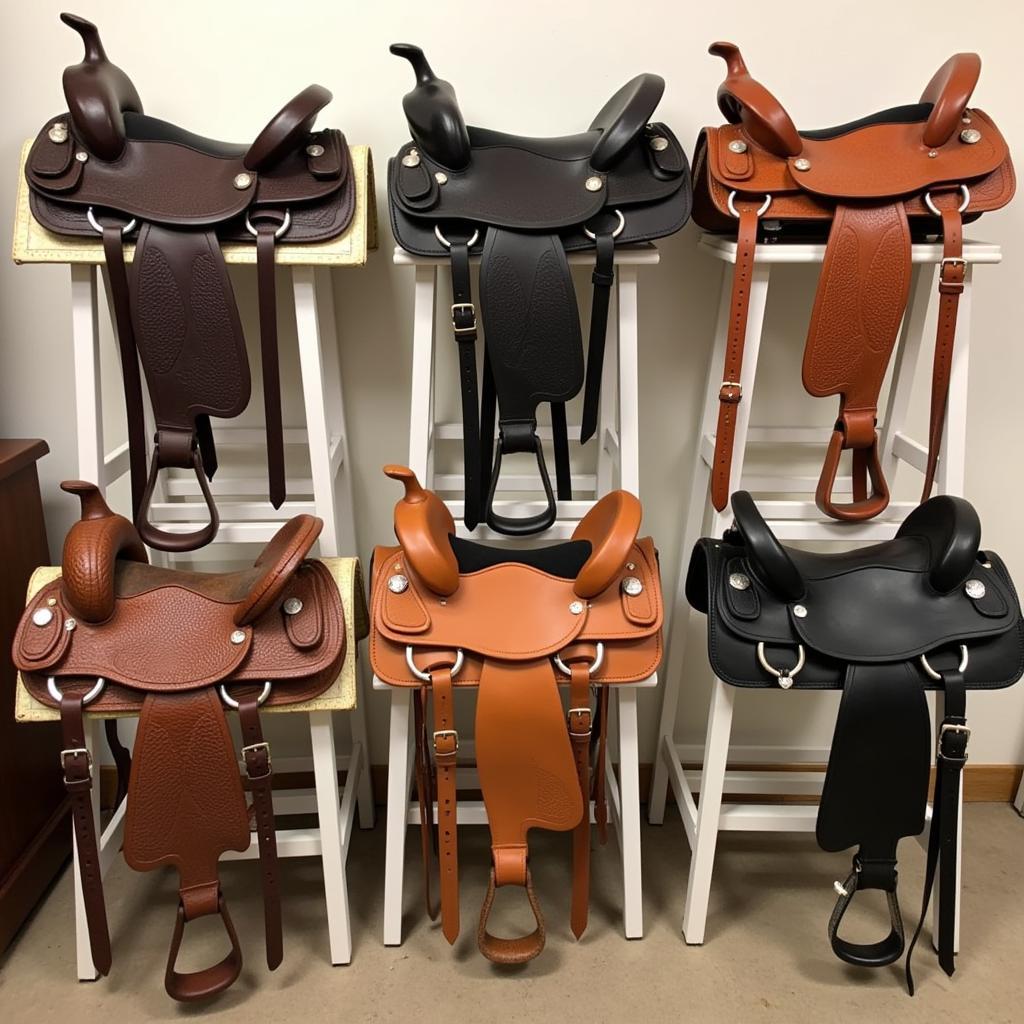Finding the perfect Horse Saddle And Accessories is crucial for both horse and rider comfort, performance, and safety. Whether you’re a seasoned equestrian or just starting out, this guide will provide valuable insights into selecting the right equipment for your needs.
Understanding the Importance of a Properly Fitted Saddle
A well-fitted saddle is paramount to your horse’s well-being and your ability to ride effectively. An ill-fitting saddle can cause discomfort, pain, and even long-term back problems for your equine partner. For the rider, an improper fit can lead to an unbalanced seat, difficulty in cueing, and overall discomfort.
Types of Horse Saddles: Navigating Your Options
 Various types of horse saddles on display
Various types of horse saddles on display
Horse saddles are broadly categorized into two main types: English saddles and Western saddles. The choice between these depends largely on the riding discipline you pursue.
English Saddles: These saddles are designed for English riding disciplines such as dressage, jumping, and eventing. They are lightweight and offer closer contact with the horse, allowing for subtle cues and greater freedom of movement.
Western Saddles: Popular for Western riding disciplines like trail riding, reining, and rodeo events, Western saddles are heavier and feature a prominent horn at the front. They provide a deep, secure seat, ideal for long hours in the saddle and working with cattle.
Within these two categories, numerous variations cater to specific riding styles and disciplines. Let’s delve into some popular saddle types:
- Dressage Saddle: Characterized by long flaps and a deep seat, it promotes a balanced and elegant riding position.
- Jumping Saddle: Features a forward-cut flap and padded knee rolls to facilitate jumping.
- All-Purpose Saddle: A versatile option suitable for both flatwork and jumping.
- Trail Saddle: Designed for comfortable trail riding with features like rings for attaching gear.
- Reining Saddle: A heavy saddle with a deep seat and low cantle, ideal for intricate maneuvers.
Essential Horse Saddle Accessories
Beyond the saddle itself, several accessories are integral to a complete and functional riding setup:
- Saddle Pad: Provides cushioning and helps protect the horse’s back from friction.
- Girth: A wide strap that secures the saddle in place.
- Stirrups and Stirrup Leathers: Provide support for the rider’s feet and legs.
- Bridle and Bit: Used to control the horse’s head and direction.
- Reins: Attached to the bit and used by the rider for communication and control.
Finding the Perfect Fit: Saddle Fitting Expertise
Getting the right saddle fit is crucial. Consulting with a qualified saddle fitter is highly recommended, especially if you are new to riding or purchasing a new saddle. A professional fitter will assess your horse’s back conformation and your riding style to recommend the best saddle options.
Caring for Your Horse Saddle and Accessories
Regular cleaning and maintenance of your saddle and accessories are essential for their longevity and your safety. Wipe down your saddle after each ride, use leather conditioners to prevent drying and cracking, and store your equipment in a clean, dry place.
Conclusion
Selecting the right horse saddle and accessories is an investment in your riding experience and your horse’s well-being. Remember to prioritize a proper fit, choose equipment suitable for your riding discipline, and invest in regular care and maintenance. By making informed decisions and seeking expert guidance when needed, you can ensure a comfortable, safe, and enjoyable riding experience for both you and your horse.
Frequently Asked Questions about Horse Saddles and Accessories
-
How often should I have my saddle checked for fit?
It’s recommended to have your saddle professionally checked for fit at least once a year, or more frequently if your horse is still growing or undergoing significant changes in weight or muscle development. -
Can I use an English saddle for Western riding or vice versa?
While it’s technically possible to ride in a saddle not specifically designed for your chosen discipline, it’s not recommended. Each saddle type is designed for specific movements and riding styles. -
What factors influence the cost of a horse saddle?
Saddle prices can vary greatly based on brand, materials, craftsmanship, and features. -
How do I know what size saddle pad my horse needs?
The saddle pad should be slightly larger than the saddle itself to ensure adequate coverage and protection for the horse’s back. -
What are some common signs of an ill-fitting saddle?
Signs of an ill-fitting saddle can include the horse showing reluctance to move forward, exhibiting behavioral issues during saddling, developing sores or white hairs in the saddle area, or displaying an uneven gait.
For additional information on horse care and riding apparel, check out our articles on winter horse riding apparel and cute casual horse riding outfits.
We understand that choosing the right horse saddle and accessories can be overwhelming. If you have further questions or need personalized guidance, please don’t hesitate to contact our expert team at Justus Horses USA. We are dedicated to helping you find the perfect equipment for your equine partner.
Call us at 0772127271, email us at [email protected], or visit us at QGM2+WX2, Vị Trung, Vị Thuỷ, Hậu Giang, Việt Nam. Our customer support team is available 24/7 to assist you.